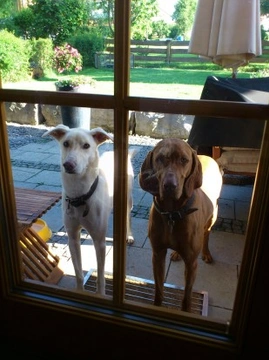
How to stop your dog from jumping at glass doors
If you have large glass panels in your doors, glass patio doors or floor to ceiling windows, the chances are that your dog will, at some point, have had trouble telling whether or not the door was open or closed, particularly if the glass is very clean!
While some dogs will learn from their mistake first time, others seem to keep on and on repeating the behaviour, risking potential injury and even damaging the door! Even if your dog is aware that there is glass in the door, being able to see out at eye level (or see back in) may encourage your dog to jump up at the glass to bark at people who come to the door, or to go out or come back in, leaving mucky paw prints all over the glass!
If your dog is obsessed with trying to go out through your glass doors or sees them as a canvas to paint with mud, it is important to teach your dog not to do this, in order to avoid injury, prevent mess, and teach your dog correct manners within the house. Read on to learn how.
Don’t use the door for your dog
Once a dog has learned that they can come in and out through a particular door, they will make a beeline to use it again in the future, so the best way to keep your dog from trying to exit through a closed glass door is to never use it as an exit for them in the first place.
If your dog is used to the door being open, for instance, in the summer, they are likely to automatically try to use it again, which might mean running into it when it is closed! They are also likely to sit by it even when they are aware that it is closed and paw at it to go out, leaving you again with a door that is covered in mud and murk.
Call your dog away from the door, and show them an alternative exit until they learn by themselves!
Deterring your dog
If your dog is not aware of when the door is closed and doesn’t notice the glass until it is too late, you will have to take steps to show your dog that there is a barrier there! Use nets, fly screens or beaded curtains to stop your dog from seeing the glass as an open portal.
If your dog still likes to paw at the glass or jump up at the door, stick large, colourful balloons to it at their level, which should stop them from jumping at the glass, and if they do, burst the balloons, giving them feedback about their actions.
Training and obedience
Obedience training and responsiveness from your dog should be at the heart of everything you do, and these skills can help you to manage every aspect of your dog’s behaviour. If your dog takes cues from you when you collect their lead for a walk and uses this as a reason to go and jump up against the door, make them sit, calm down and wait before you attach their lead.
Teach them that they must be calm and not jumping up before it is time to go, and always ensure that your dog waits for you to walk out through the doorway first.
Use a noisemaker to provide feedback
An empty tin with dried peas or a few coins in it can make quite a racket when shaken up, which will almost certainly divert your dog’s attention from whatever they are doing and cause them to look your way. Keep this to hand when you are in sight of the door, and when your dog gets up close to it or jumps up, shake the tin to break your dog’s thought process and divert their attention.
Then, call them away from the door, and offer a treat or praise for their compliance.
Give your dog plenty to do
If your dog is apt to sit by the door waiting for something to happen or some stimulus to occur, the chances are that they are rather bored, and fixating on the door as a way to entertain themselves.
Giving your dog a well-rounded, active life with plenty of exercise and mental stimulation will minimise this behaviour, and potentially prevent a lot of other behavioural problems too.
Don’t leave your dog at home alone for hours and hours every day, and make sure that you spend plenty of quality time with your dog when you are at home with them. Take your dog on plenty of walks, enable play, and ensure that your dog has lots of toys and things to do when they are at home on their own.



